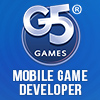Agharta Studio was created in November 2008 after the current team members left their respective game development studios: Etranges Libellules for 2D artist Valerian Taramon and creative director and game designer Alexandre Leboucher, and Eden Games for CEO and programmer Aurelien Kerbeci. Jean Edouard Fages, formerly of Arkane Studios, joined the team in 2012 to give a hand on 3D and design for Shufflepuck Cantina, the game whose story Alexandre shares.
In 2008, right in the beginning of the AppStore, we released the first episode of the 1112 series, which sold very well along with its two sequels. In 2010, in between two episodes of 1112, we tried the publisher route (a catastrophic experience for us) with a game in the style of Advance War (Nintendo DS) called Rogue Planet. Each of our projects has been large in scope, and took a year on average to complete.

Taking the Initiative
For me, there’s always been a dream project. I remember fondly the years spent on Shufflepuck Café back in the 80’s-90’s. The game was one of my all-time favorites along with Dungeon Master, Ultima, and Wizardry series. The year before we started the project, I stumbled into Legend of Grimrock, which was a reimagining of one of the legendary games of my youth. The game sold almost a million and generated a lot of buzz on the internet. Tired of waiting for a Shufflepuck Café remake, I decided to advocate the project within my own team.

With the Grimrock argument, lack of direct competitors, and a huge untapped market ahead, they quickly agreed to make the jump. At the time, I also tried to reach the original creators of Shufflepuck Café, but they seemingly had disappeared from the surface of the gaming world.
The Biased Market of PC
We had to choose a market where the game would have the biggest impact. We would have loved to make it on Mac and PC to reach the fans of the original, but at that time, everyone told us it was suicide to market a game on the PC without financial means or a publisher to back us up. This was before the start of Valve’s Steam Greenlight program. So we went for iOS, considering our strong backgrounds on the platform and the ease of producing a game on it. But in the PC community, there’s a bias against games successful on iOS (which are considered ports), and this consequently undermined the press coverage and general interest in our game.
From 2D to 3D
At first, I was aiming for a simple remake in 2D, since high-quality digital paintings have always been our strong point. The 1112 series and Rogue Planet were mostly 2D with scarce 3D elements.

With the arrival of Jean Edouard, we were able to make 3D assets on a completely different scale, so we decided to go full 3D for the project. The game development schedule was doubled, and we entered the uncomfortable position of looking less and less like a traditional indie game. Most people didn’t realize that we were only are a 3-4 person team. On a side note, we used Blender to make all of our 3D assets and we tried (without any real coverage) to speak about it in the Blender/free software communities. However, that didn’t give any noticeable results - those hangouts aren’t full of gaming enthusiasts.
Own Engine: Hard to Make, but Worth It
The main drawback of making our own 3D engine is the amount of time required to develop it and the tools to exploit it. Aurelien had already created a functional 3D engine at the time, and we used it on our previous productions.
There was a lot to do, considering the amount of needs we had for Shufflepuck. We had to invest a lot of R&D time and budget in that engine, especially for the PC version, with features including deferred rendering, dynamic lights and shadows. In the end, it really proved itself, and the game is ultra-optimized with no loading time at all, which is a feat on mobile devices when compared to all Unity/Unreal engine games out there. The other positive aspect is that if we decide to keep using our in-house engine, most of the R&D is already done, which will save time in the future, especially for porting, as the engine now supports Windows, Mac OS, iOS and Android frameworks.
Pros and Cons of Non-Aggressive IAPs
Another big hurdle was how to choose the pricing model. The game has a lot of content and was designed to be a premium title, but we decided to experiment with a freemium model since we never tried that in the past. Adding a monetary system was quite natural for the game, but I really wanted to avoid pressure on customers, so we handled the in-app purchases with care, only requiring one IAP to double all amount of the in-game currency, which gives the player exactly what is needed to grind through the game the same way a typical RPG would.

And then the game was out! Luckily, the team at Apple immediately noticed the great quality of the title and we had good coverage in US and Europe for a week, and minor coverage for the following months. Within the first two months, we managed to reach 1.2 million downloads. However the IAP ratio was catastrophic! Since we didn’t choose an aggressive IAP strategy, few players were compelled to make an IAP.
The game was being played very often; we had some players who played more than 300 hours. I immediately thought that we should limit the access to the game tables with the money system, but I couldn’t stand the thought of being a money-hungry machine at the detriment of the player.
Still, players seem to love the game with 9000 reviews at 4.6 out of 5 average, and the press mostly rated the iOS version quite high.
The Big Mistake: Forgetting Ads
And then we realized that deciding to not include ads in a freemium game is absolute suicide if your game is not heavily marketed. Two months after release, we added ads in the game: Chartboost and NativeX. The latter is non-intrusive and allows players to earn in-game currency if they agree to watch some targeted ads or videos.
Immediately, the cash came in. Ads were giving roughly three times more than IAPs! But it was a bit too late; we weren’t heavily featured anymore. As of today, we’ve reached 1.6 million downloads for Shufflepuck Cantina on iOS and only 400,000 units were delivered with ads. We somehow managed to earn $150K anyway, but we would’ve earned 2-3 times more if we had just included the ads at launch time.
The Android Debacle
Still frustrated by the missed ads opportunity, we started to listen to friends who kept asking for an Android version of the game. The numbers were huge everywhere we looked: Android was said to be selling big; there was information about many people switching to it as well as about the market having 10 times more users. Android at that time looked like a brand new Eldorado waiting for us to make some good old port cash. The task took a lot longer than expected due to inherent Android technical issues including horrible fragmentation. We had to rent 20 different devices with different OS versions, and at launch, the game was working on only half of those Android machines.
I made contact with some Google guys to get us featured, and we finally launched the game. Since there are not many professional Android websites, press coverage is even worse than for iOS, but the worst of all was the editorial team at Google. I spent three months exchanging emails with guys who seemed interested in featuring the game. Still, the Google Play homepage almost never changed during those three months. They kept featuring low-quality pong games and had nothing about a premium quality Shufflepuck Cantina. In my opinion, Google needs to hire a lot more people and start looking at what’s going on at Apple.
Despite having excellent reviews on Google Play (4.7 out of 5), the free version of the game was only downloaded 10,000 times - 150 times fewer than the iOS version. And, worst of all, the ad revenues were 10 times lower than on iOS for the same amount. To this day, we somewhat managed to only get $1,000 - $2,000 on the Android market in a whole year.
Getting Greenlit isn’t Fast
Shortly before starting the Android version, we tried to apply for the Steam Greenlight program for a potential PC version. After all, the PC version always was the target we had in mind to reach, for the original PC/Mac players of Shufflepuck Café. At that time, there were thousands of games waiting in the Greenlight queue, and only 3-4 were released each month.
We didn’t have any big hopes about releasing the game on Steam anytime soon. Still, we tried hard to make a great PC version of Shufflepuck Cantina, enhancing the engine, creating a big boss, and a real ending. It took six more months to finish the PC game, which was about the time needed to be greenlit. We didn’t have time to make multiplayer, but planned to add it and more interesting mechanics to enhance gameplay once the game is sold well enough.

Struggling for Press Coverage
The game became available on Steam just one week after the two behemoth consoles from Microsoft and Sony came out, so all the press was solely focused on those. Even with a lot of contacts in the press industry, we didn’t manage to have a single review of the game neither at launch nor during the following months. Once a game is out and doesn’t have any buzz at launch, the press is not interested. The game slightly benefited from being featured in Steam’s news section for a few days, but this was only enough to sell a couple of thousand units. On the other hand, this seems to be okay in the PC crowd for indie titles. The player reviews are really good so far; 86% positive reviews out of 300.
After a couple of months, we were harassed by “bundle” websites, and delivered 50k units that way, which was another big mistake. The revenue share from bundles is next to nothing and it’s basically destroying your “waiting for sales” user base. Of course, we were never featured on “winter/summer” Steam sales since they only feature game that are already selling well to increase their cash.
Oculus: UI and VR Restrictions
We have owned an Oculus for a year now, and we paralleled the development on it because we think it’s most certainly the media of the future. We scored a good spot at last summer’s Oculus jam with Epic Dragon, and made a very nice demo version of Shufflepuck Cantina (available through Steam) for it as well, hoping to make the full version if the game was successful enough on Steam. It was an interesting take on user interface and VR restrictions, I strongly suggest new Oculus players to try it out, and Epic Dragon as well.

Mixed Feelings
I have mixed feelings about the whole Shufflepuck Cantina launch and development. We managed to port our technologies and knowledge over all mobile devices as well as desktop machines, learned a lot about freemium vs premium, set foot inside Steam, gave a huge boost to our online community (9K followers on Twitter, 25K on Facebook), met a lot of interesting people, and generally improved our tech.
On the other hand, the creation process was a bit unfocused: we added a lot of core features into development a bit late, spent too much time on detailed metagame mechanisms few players really cared about, didn’t communicate enough before the game was finished, wasted six months on Android for nothing, and, last but not least, emptied the company’s treasury instead of making it viable.
The Agharta Studio team is now working on a full Oculus DK2 version of Shufflepuck Cantina (hoping to be one of the very first full games compatible with the DK2), and on a very cool iOS Rogue-like game. The developers say they’re going to try pushing the full Oculus version of the game and using the earnings to move to all possible events to show their games and communicate more with the press and public.
Comments









